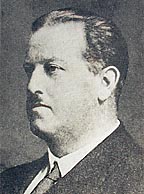Lennart von Post
| Ernst Jakob Lennart von Post | |
|---|---|

Lennart von Post
|
|
| Born |
16 June 1884 Johannesberg, near Västerås, Västmanland County, Sweden |
| Died | 11 January 1951 (aged 66) |
| Residence | Sweden |
| Nationality | Swedish |
| Fields | Geology, Botany, Palynology |
| Institutions | Swedish Geological Survey, |
| Alma mater | Uppsala University |
| Known for | Palynology, Quaternary geology |
Ernst Jakob Lennart von Post (16 June 1884 – 11 January 1951) was a Swedish naturalist and geologist. He was the first to publish quantitative analysis of pollen and is counted as one of the founders of palynology. He was a professor at 1929–1950.
Lennart von Post was born in Johannesberg, near Västerås in Västmanland County, Sweden. Von Post was an only child. His father served in the Swedish Army as a judge-advocate but also worked as a civilian lawyer, farmer and assistant cantonal judge. His mother Beata Jacquelina Charlotta Christiana Nisbeth died a year after his death.
Von Post studied geology at Uppsala University from 1902–1907, eventually obtaining his licentiat degree. At Uppsala he learned from lecturers such as A.G. Högbom, who developed the concept of the geochemical carbon cycle and Rutger Sernander, of the Blytt-Sernander sequence. Von Post began working on a history of the development of the Mästermyr marsh on Gotland with Jakob Ljungqvist in 1902. This was likely the first research project von Post was involved with, however his first publications appeared in 1903, describing the Littorina wall. This paper was important since it described, along with another paper by Kjellmark, layers of Littorina shells in beach exposures leading to estimates of isostatic rebound and post glacial transgression in Sweden.
Von Post worked for the Swedish Geological Survey for 21 years as a peat specialist. During this time he developed the technique of using pollen grains to build stratigraphies that could be used to correlate peat layers locally. By 1916, along with work by (Gustav?) Lagerheim for N.O. Holst, the concept of using pollen to describe immigration of plant species and changes in the relative numbers of plants took hold. This work led to the publication of the first modern pollen diagram in 1916, the same year that von Post presented his now famous lecture in Christiania, although the two pertained to different subject matter.
...
Wikipedia
